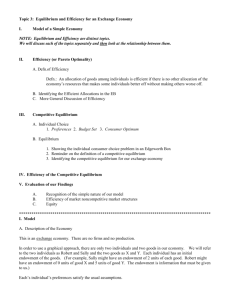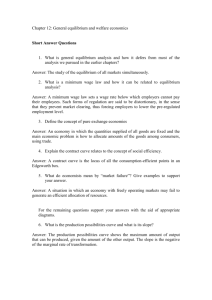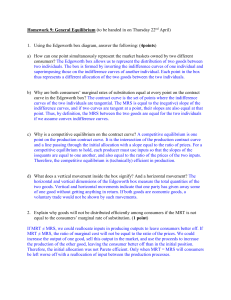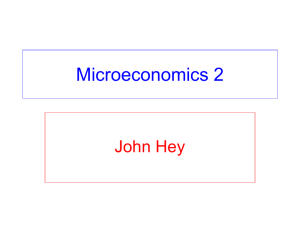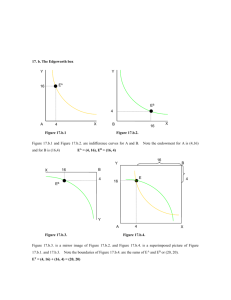1 spp - Mircea Trandafir
advertisement
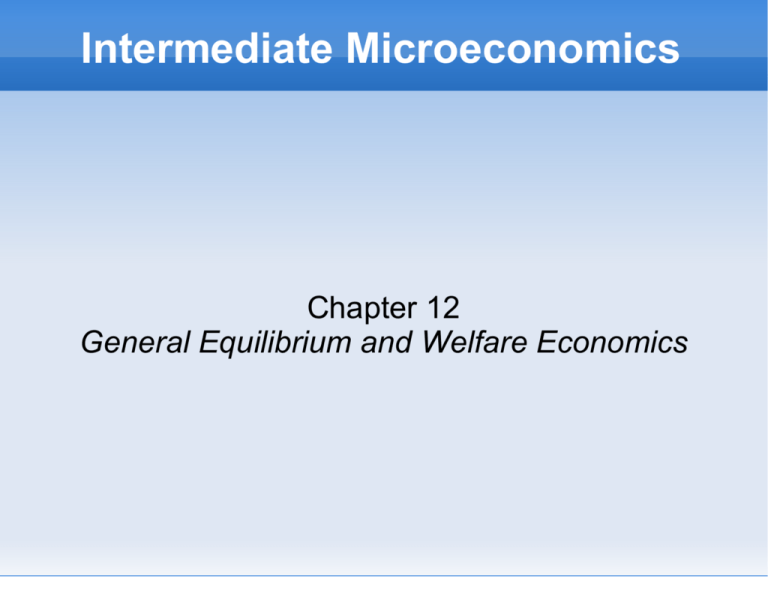
Intermediate Microeconomics Chapter 12 General Equilibrium and Welfare Economics Partial vs general equilibrium Partial equilibrium = study of equilibrium in one market in isolation General equilibrium = study of equilibrium of all markets simultaneously Until now, we only looked at one market at a time (partial equilibrium) exception: increasing-cost industry analysis But: changes in one market can (and usually do) affect other markets as well 2 Example: tax on beer Market for beer Market for wine P P S'B SB DB D'B Q SW D''W DW D'W Q 3 Partial vs general equilibrium If two goods are related (complements or substitutes), then their markets are linked Changes to demand/supply in one market affect the equilibrium in linked markets Partial equilibrium analysis would not consider all this feedback between linked markets 4 Pure exchange economy Pure exchange economy = economy in which quantities supplied if all goods are fixed the only economic problem is to allocate goods among consumers A simple case: two consumers, two goods Can be represented in an Edgeworth box Since there''s no production, each consumer has an endowment of each good endowment point 5 Edgeworth box Total quantity of good y x1 Person 1 x2 Person 2 y2 Endowment point y1 Total quantity of good x 6 Edgeworth box indifference curves Person 2 IC2 IC2' IC2'' IC1'' IC1' IC1 Person 1 7 Edgeworth box budget line Person 2 Endowment point Budget line: slope = px / py Person 1 8 Equilibrium in Edgeworth box Prices are not given in this setting (consumers trade for the two goods) Hence, an equilibrium consists of: prices (of good x and good y) consumption bundles (for the two consumers) such that: consumers maximize their utility quantity demanded equals quantity supplied for both goods 9 Edgeworth box equilibrium Person 2 Endowment point IC2 Equilibrium IC1 Person 1 10 Equilibrium in Edgeworth box At the equilibrium, the indifference curves of the two consumers are tangent to each other and to the budget line MRS1 = MRS2 = px / py This also gives us the equilibrium price ratio: note that we don't obtain prices, but only the ratio between the two prices! Also note that prices act to clear the market: in equilibrium, prices adjust such that neither individual needs to know what the other does (their own decision are optimal) 11 Welfare economics Welfare economics = branch of economic theory concerned with the social desirability of alternative economic states Consumption efficient allocation = allocation of commodities such that, given the total supplies of the commodities, the only way to make one person better off is to make another person worse off point of tangency of indifference curves of the two consumers (MRS1 = MRS2) Contract curve = set of all consumption-efficient 12 points in an Edgeworth box Edgeworth box contract curve Person 2 Contract curve Person 1 13 Production efficiency What if goods are being produced? We can use the same kind of analysis (Edgeworth box + efficiency) to analyze production: goods instead of consumers inputs instead of goods Production efficient allocation = allocation of inputs such that the only way to increase the output of one commodity is to decrease the output of another commodity 14 Edgeworth box for production Total quantity of capital Good y Good x Isoquants for production of good x Isoquants for production of good y Total quantity of labor 15 Production-efficient allocations Good y Production-efficient allocations Good x 16 Production possibilities curve When the economy is producing efficiently, the only way to produce more of good x is to give up some of good y Production possibilities curve (PP) = set of all production-efficient points Marginal rate of transformation (MRT) = rate at which the economy can transform one output into another by shifting its resources Slope of production possibilities curve = MRT Also, MRT equals the ratio of marginal costs 17 Production possibilities curve Good y PP curve: slope = MRT = MC x MC y Good x 18 Pareto efficiency Pareto efficient allocation = allocation of commodities and inputs such that the only way to make one individual better off is to make another worse off Hence, Pareto-efficient allocations must be: consumption-efficient (on the contract curve) production-efficient (on the PP curve) allocation efficient = allocation of goods such that the MRT between any two goods is equal to consumers' common value of the 19 MRS between the two goods Pareto efficient allocations Good y slope = MRT slope = MRS Person 2 Pareto-efficient allocation Person 1 Good x 20 Utility possibilities frontier By changing the point on the PP curve, we can find all the Pareto-efficient points we can find the optimal utility levels for both consumers Utility possibilities frontier = graph that shows the maximum amount of utility an individual can obtain, given another's level of utility All points on the utility possibilities frontier are Pareto efficient (no Pareto improvements) Pareto improvement = reallocation of resources that makes at least one person better off 21 without making anyone else worse off Utility possibilities curve Person 1's utility Utility possibilities curve (Pareto efficient allocations) Not Pareto efficient Person 2's utility 22 First Welfare Theorem First fundamental theorem of welfare economics: As long as producers and consumers act as price-takers and there is a market for every commodity, the equilibrium allocation of resources is Pareto efficient. That is, the economy operates at some point on the utility possibilities frontier. This is just Adam Smith's invisible hand claim: left alone, the market automatically allocates resources efficiently (no need of centralized direction) 23 Fairness and the role of prices In a market economy, prices act as to clear the market (equate quantity demanded and quantity supplied) Goods don't have an inherent value: prices only reflect the interaction of market demand and supply So, are prices (or wages) fair? First Welfare Theorem only talks about efficiency, not fairness! 24 Theory of second best In practice, it might not always be possible to attain efficiency (e.g., there might interventions of government that can't be eliminated) Theory of second best = if a first-best allocation is impossible to obtain, then a second-best allocation may involve the introduction of additional wedges between price and marginal cost In other words: two wrongs can make a right 25 The role of government First Welfare Theorem might fail in practice because of market failures: market power (some firms/consumers are price makers) missing markets (some goods cannot be traded) due to asymmetric information or externalities government intervention (correct market failures, introduce or substitute for missing markets) Even if it does not fail, the resulting allocation might not be deemed equitable government intervenes to reallocate commodities 26
